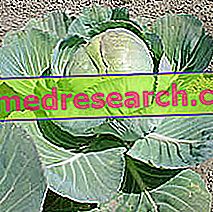What are
What are tropical fruits?
The tropical fruits, better identifiable as exotic fruits, are foods of plant origin available on the Italian market almost exclusively thanks to import.

Foods rich in vitamin A or vitamin C should be included in the VI and VII fundamental group of foods - but, as we shall see, they do not always meet the criteria of this classification.
The dietary role of tropical fruits can change significantly based on the nutritional composition. In a simplistic way, we could say that the acidulous and sweet ones have the same functions as our own fruits, while the fat tropical fruits should be treated in the same way as dried fruit or oil seeds.
They can be very different or similar to Italian fruits, depending on the aspect to be analyzed - organoleptic and taste characteristics, nutritional properties, price and food safety. This depends on the species and the origin, therefore on the environmental and climatic factors required by the plant.
Some examples of tropical fruits normally consumed in Italy are: bananas, pineapples, coconut, papaya and mango. On the other hand, the market is constantly expanding and today, compared to the last twenty years, the commercial proposal of tropical fruits - even retail - has increased significantly.
Let's go into more detail.
Tropical VS Italians
Nutritional differences between tropical fruits and Italian fruits
As anticipated, not all fall clearly within the VI and the VII fundamental food group - classification proposed in collaboration between "National Research Institute for Food and Nutrition (INRAN)" and "Italian Society of Human Nutrition (SINU)" .
The typically Italian fruits, acidulous, succulent and sweet, have more or less similar characteristics; in short, we could call them abundant sources of:
- water
- Soluble carbohydrates, in particular the fructose monosaccharide
- Dietary fiber (soluble and insoluble) and other prebiotics (carbohydrates not available)
- Water-soluble and fat-soluble vitamins, in particular vit C (ascorbic acid), vitamin A and provitamins A (retinol and retinol equivalent, such as carotenoids)
- Minerals, in particular potassium and magnesium
- Phenols and tannins
- Phytosterols.
Containing irrelevant amounts of proteins and lipids, they show a caloric intake usually of low or medium size.
Among tropical fruits, on the other hand, we also find very caloric products, with a prevalence of fats - moreover of a saturated type - and abundant quantities of nutrients that are usually not present - such as alpha tocopherol or vitamin E. This is the case, for example, of avocado and coconut.
The fact remains that even in Italy there are exceptions; the most indicative example is undoubtedly that of chestnuts, much less hydrated and rich in starch, therefore more caloric. The same goes for oilseeds or dried fruit - nuts, hazelnuts, pine nuts, almonds, pistachios - as abundant sources of fat, and therefore of calories, of fat-soluble vitamins - especially vit E - and of different minerals - for example selenium and football.
Food safety differences between tropical fruits and Italian fruits
Speaking of food security, things get complicated. Not so much for real issues related to the hygienic safety of products, but for the evolution of international trade relations and the consequent adaptation - which took place especially in the last thirty years.
The consumption of tropical fruits could be harmful only in two cases:
- The first is that of a bad state of preservation; rather rare eventuality, since the consumer is generally able to verify the wholesomeness of the product effectively. Moreover, from a microbiological point of view, there are very few pathogens capable of proliferating on fruit. Particular attention should be paid to the development of molds, which in plant-based foods are most responsible for harmful contamination.
- The second is that of chemical contamination. In turn, this can be further divided into:
- Pesticide residues or other products aimed at optimizing agricultural production, or maintaining the integrity of tropical fruits during transport and storage
- Environmental pollution or other forms of unwanted contamination.
The presence of pollutants and pharmacological residues seems to worry Italian consumers the most. Obviously this does not only apply to tropical fruits, but to all imported ones, both from inside and from outside the European Community.
After all, how to blame those who, in light of the scandals and discoveries made earlier, fear for their own safety and that of their family. Fortunately, today these concerns are less well founded than in the past. In fact, the expansion of the market and globalization have imposed greater controls, especially at the borders. This is why agricultural enterprises located in developing countries, repeatedly rejected when entering Europe and Italy, have been forced to adapt their production methods.
Until proven otherwise, then, everything that enters our country legally is subject to rather scrupulous checks, which has really reduced the cases of health food fraud to the bone.
Price differences between tropical fruits and Italian fruits
If on the one hand tropical fruits fascinate consumers with their appearance, aroma and exotic flavor, on the other hand they discourage the less well off due to their exorbitant cost; today it has become almost a luxury to be able to enjoy the local fruits grown in Italy, without having to go through the offers from overseas or the Far East.
To be honest, the production and distribution of tropical fruits could be more than affordable. In fact, many of these have no real seasonality and are produced almost all year round. Moreover, transport by sea, the most widely used, is quite efficient and saves not a little compared to air travel, but also in proportion to road transport. It seems instead that it is the business itself that has the greatest impact, that is the profit margin of the merchants, both in production and in distribution - if the companies are different.
What are they?
What are tropical fruits?
Among the most commercialized tropical fruits in Italy we can identify some already deeply rooted in the local gastronomic culture, others known but valued "niche" and some instead considered by most as "new arrivals".
Common tropical fruits
- Banana
- Pineapple
- Coconut
- Avocado
- Dates
Niche tropical fruits
- lime
- Mango
- Papaya
- Litchi
- alchechengi
- Carambola
- plane tree
- Bananito
- Red bananas
- Tamarind
- Baby kiwi
New tropical fruits
- Kumquat
- Buddha hand
- Mangosteen
- cherimoya
- Fejoa
- Maracuja
- Durian
- Guava
- Kiwano
- Finger lime
- Kaffir lime
- Pitaya
- Granadilla
- Pepino
- Salak
- Graviola
- tomatillo
- Lucuma
- Lulo
- Curuba
- Sapodilla
- Giaca
- Longkong
- Sapote.
provenance
Where do tropical fruits come from?
The adjective "tropical" clearly specifies the origin of these products, that is the geographical area - a real band that surrounds the whole globe, between the tropic of cancer and that of capricorn, respectively positioned north and south of the equator. It must also be remembered that, in reality, most tropical fruits are not produced exclusively between the two tropics, but also slightly above that of cancer and slightly below that of capricorn, areas characterized by a non-tropical climate (dry or humid) but subtropical wet, or Mediterranean, sometimes dry or semi-arid.
Not everyone knows that most "local" fruits are not, in truth, native to the Italian peninsula. Yes, peaches, apricots, kiwis, apples, pears, pomegranates, citrus fruits, prickly pears, jujubes and many others are the result of such an ancient import that they have lost their memory - we are talking above all about the Roman Empire's commercial network with the 'Africa and the Middle East, in turn in connection with the Indian sub-continent and even more to the east, then that of the Maritime Republics directly with Asia, of the discovery of the New World and subsequently of the emerged lands on the Pacific Ocean.
On the other hand, these are not tropical fruits because they are mostly related to a temperate climate; otherwise they could not prosper in Italy. In fact, we must not make the mistake of thinking that, for the cultivation of fruit, the warmer it is the better; on the contrary, there are plants that require rather harsh temperatures to start the flowering and fruiting metabolism. Excessive temperatures combined with low rainfall put the majority of trees in crisis, as well as excessive humidity is able to promote diseases such as the feared fungal infections. So, if apples are not grown where coconut is grown, almost always the opposite is also true.
To complicate matters, furthermore, there are: the so-called climatic promiscuity and adaptability, the selection in cultivars with different characteristics, and altitude - a plant can grow in a tropical zone but at an altitude such as to face a totally different climate; this applies to all types of fruit, both pseudo-Italian and tropical.
Ultimately, "tropical" means everything and nothing. Every fruit tree is born and thrives in a different climate - with unique elements and geographical areas as well as different types of soil and other environmental conditions. It turns out that, on balance, the term "tropical fruits" has very little meaning and can be rightly traced back to the activity of importing from countries characterized by a warmer, sometimes wetter, climate than the Italian one.



